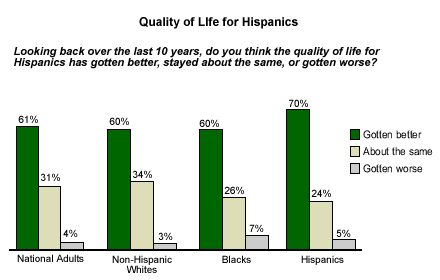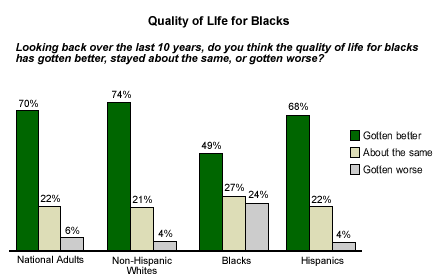Hispanics have now overtaken blacks as the largest U.S. minority. Although many Hispanics are recent immigrants and tend to have less education and fewer economic advantages than other Americans do, Gallup polling indicates that on average they tend to be extremely positive about their quality of life in this country.
Hispanics Optimistic About Quality of Life
As part of its June 2003 Minority Rights and Relations survey*, Gallup asked Americans, "Looking back over the last 10 years, do you think the quality of life for Hispanics has gotten better, stayed about the same, or gotten worse?" The overall population seems to be fairly positive on this issue -- 61% of U.S. adults said that the quality of life for Hispanics has gotten better, while 31% said it's about the same and 4% said it has gotten worse. However, Hispanic respondents were even more optimistic than the overall sample -- 70% of Hispanics think their quality of life has gotten better, compared to 24% who think it's about the same and 5% who think it's worse.

The likelihood of Hispanics to believe that their quality of life has improved over the last decade may not be a complete surprise. Most Hispanics are immigrants themselves or the children or grandchildren of immigrants, and may therefore feel that their circumstances in the United States are far better than the conditions they left in the countries from which they emigrated.
Also, the economic boom of the 1990s allowed many Hispanics to move into the American middle class. For example, according to a July 13 story in the Atlanta Journal and Constitution, increased buying power has accompanied the population boom in Georgia. The buying power of Hispanics in Georgia increased from $1.39 billion in 1990 to $11.25 billion in 2002. The buying power of Hispanics nationwide more than doubled during the same period, from $223 billion to $580.5 billion.
Optimism About Quality of Life Not Shared by Blacks
Hispanics' typical feeling that their own quality of life is on the rise is particularly noteworthy when compared to results for the same question among blacks. The overall U.S. population is even more optimistic that the quality of life for blacks has improved than it is that the quality of life for Hispanics has improved; 70% of Americans think that the quality of life for blacks is better now than it was 10 years ago (compared to 61% who think the same thing about Hispanics).
Blacks themselves, however, do not share this sense of optimism. Just under half (49%) of blacks feel that their quality of life has gotten better. Twenty-seven percent think things have stayed the same, and a nearly equal percentage (24%) feel that their quality of life has gotten worse. Although the 49% of blacks who said their quality of life has improved is lower than other racial and ethnic groups' levels, it is the highest percentage to say so in more than 20 years.

Bottom Line
Although blacks and Hispanics share the distinction of being the two largest minority groups in the United States, they differ from each other in many ways. Most black families have been in America for several generations, and are likely to have suffered injustice and oppression in the United States. The history of Hispanics as a prevalent minority group in America is much shorter than that of blacks; with any luck, their expectations regarding quality of life will continue to improve as the Hispanic population becomes a more firmly established segment of American society.
*Results are based on telephone interviews with 1,385 national adults, aged 18 and older, conducted June 12-18, 2003, including oversamples of blacks and Hispanics that are weighted to reflect their proportions in the general population. For results based on the total sample of national adults, one can say with 95% confidence that the maximum margin of sampling error is ±3%.
Results for the sample of 241 blacks, aged 18 and older, are based on telephone interviews conducted June 12-18, 2003. For results based on the total sample, one can say with 95% confidence that the margin of sampling error is ±7%.
Results for the sample of 266 Hispanics (including 12 Hispanic respondents who identify their race as black), aged 18 and older, conducted June 12-18, 2003. For results based on the total sample, one can say with 95% confidence that the margin of sampling error is ±7%. (53 out of the 266 interviews with Hispanics were conducted in Spanish.)
In addition to sampling error, question wording and practical difficulties in conducting surveys can introduce error or bias into the findings of public opinion polls.
